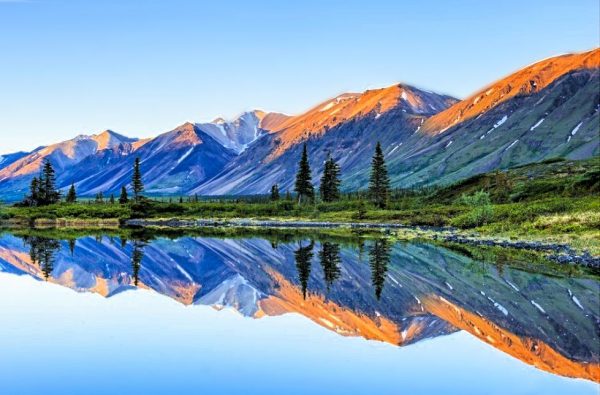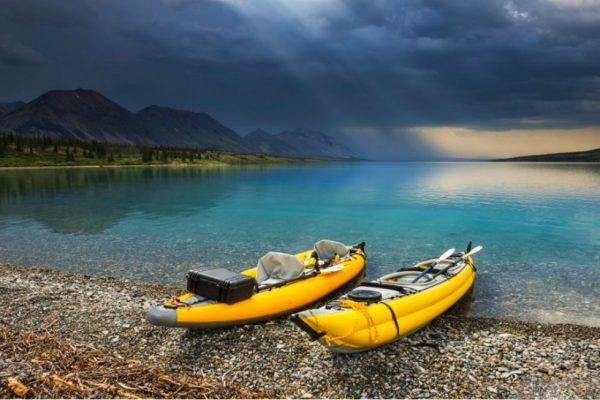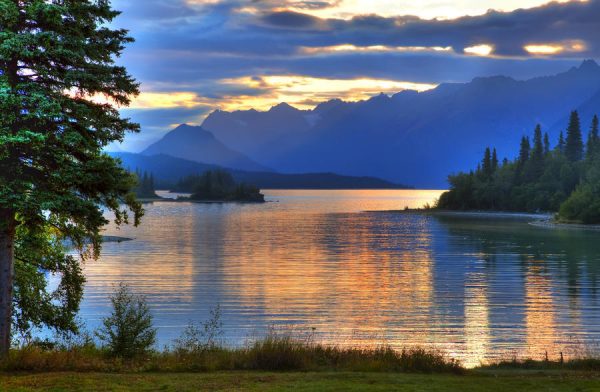Lake Clark National Park and Preserve is a United States National Park in Port Alsworth, Alaska. It was first proclaimed a national monument in 1978, then established as a national park and preserve in 1980 by the Alaska National Interest Lands Conservation Act.
About two-thirds was designated wilderness. While both sport and subsistence hunting are permitted in the national preserve lands, only subsistence hunting by local residents is permitted within the national park.
The park includes many streams and lakes vital to the Bristol Bay salmon fishery, including its namesake Lake Clark.

Morning light on Chigmit Mountains in Twin Lakes area of Lake Clark National Park & Preserve, Southcentral Alaska. Buy this print
Lake Clark National Park and Preserve covers 4,030,015 acres (1,630,889 ha) at the base of the Alaska Peninsula in southcentral Alaska, about 100 miles (160 km) southwest of Anchorage.
Of the total area, about 2,637,000 acres (1,067,000 ha) lie in the park and 1,400,000 acres (570,000 ha) in the preserve. The park and associated national preserve extend from the Cook Inlet across the Chigmit Mountains and the Neacola Mountains, on the northern end of the Aleutian Range, and on into the Alaska interior.
The national preserve lands adjoin park lands on the west. A wide variety of recreational activities may be pursued in the park and preserve year-round.
The park includes a variety of features not found together in any of the other Alaskan Parks: the junction of three mountain ranges, a coastline with rainforests along the Cook Inlet, a plateau with alpine tundra on the west, glaciers, glacial lakes, major salmon-bearing rivers, and two volcanoes, Mount Redoubt and Mount Iliamna. Mount Redoubt is still active, having erupted in 1989 and 2009.
Lake Clark is one of the National Park System’s true gems—a large sliver of all of the best parts of Alaska rolled into one easy-to-get-to place. It is almost as if Mother Nature created it with explorers in mind, offering diverse environments for mountaineers, backpackers, paddlers, big-game fisherman, hikers, and photographers to play in.
The lake that bears the park’s namesake—Lake Clark—is a vividly turquoise colored body of water that is fed by glaciers, waterfalls, rivers, and streams. It is the sixth largest lake in Alaska, 860 feet (260 m) deep and 42 miles (68 km) long.
Lake Clark is surrounded by volcanoes, mountains, tundra, other freshwater lakes, forest, meadows, marshes, bogs, and sandy coastlines.
History of the Area
The earliest human presence known in the area of Lake Clark was at Bristol Bay. People of the Paleo-Arctic Tradition lived there between 10,000 years before the present and 7500 BP.
These people were followed by the northern Archaic tradition between 6,000 BP and 4,000 BP. Two sites from this tradition have been documented in the park.
The Arctic small tool tradition followed from about 5,000 BP to 3,000 BP. The Norton tradition came between 2,200 BP and 1,000 BP, concentrated around Bristol Bay.
The Thule Tradition was established around 2,000 BP and lasted until historic times.
The northern Athabaskan Dena’ina presently live in the area. Kijik village is the primary archaeological site in the park, inhabited by Dena’ina until the early 20th century. Settlements have also been documented around Chinitna Bay.
The Cook Inlet was surveyed by British Captain James Cook in 1778. In succeeding decades Russian traders established themselves in the region.
The major settlement during the 19th century was at Kijik, with a population in the low hundreds.
By the 1890s American traders had arrived in the area, meeting a native population that had been greatly reduced by imported diseases. Kijik has been designated a National Historic Landmark district.
In 1930 the first floatplane landed on Lake Clark. In 1942 the first air taxi service was provided to Lake Clark, run by Leon “Babe” Alsworth, Sr. to Port Alsworth.
Getting There

Lake Clark, Lake Clark National Park & Preserve, Alaska – Buy this print
Like most of Alaska’s national parks, it is one of the least visited of all 59—many have never even heard of it—a major draw for Alaska’s adventure circuit and residents alike who go there for its remoteness and untrammeled beauty.
No roads lead to the park and it can only be reached by boat or small aircraft, typically floatplanes. Flights are made easier with daily routes from Anchorage located just 100 miles away, but because this area is so rugged many don’t even know where to start planning an adventure to Lake Clark.
To help with that, we are breaking down ways to discover it that together fulfill a cultural, wilderness, and wildlife experience—on the lake, in the mountains, and by the sea.
Exploring Port Alsworth and Lake Clark
About 40 minutes by float- or bush-plane from Anchorage resides the small lakeside community of Port Alsworth on the southwestern edge of the park. In Port Alsworth, a little bit of everything can be found.
There are several lodges, the most popular being the Farm Lodge that is owned and operated by the Alsworth family who are 2nd, 3rd, and 4th generation ascendants of the community’s founder: Babe Alsworth, a missionary and bush pilot who laid down roots in 1950.
Nearby are 10 waterfront lodges overlooking a protected bay where kayaks float, motorboats scoot off for fishing adventures, and seaplanes come and go ferrying passengers in and out of relaxed stays and backcountry adventures.
The first stop for most in Port Alsworth is at the Lake Clark National Park Visitor Center where backcountry permits and information are issued to incoming travelers.
Nearby are several awesome day hikes—two of the most popular being the short and easy hike to Tanalian Falls; and a more difficult trek to the top of the Tanalian Mountain that towers over the bay where you can take in amazing panoramic views of Lake Clark and the surrounding mountains.
Five other settlements are within the park, populated mainly by Dena’ina natives. Prior to the park’s establishment isolated cabins were scattered around the region. Other private lodges are scattered around the park.
The Port Alsworth setting is peaceful, but as it is the main thoroughfare to the national park, it is not without its fair share of people.
Greater solitude can be found in the backcountry Lake Clark wilderness, and Port Alsworth is the perfect jumping off point to get you there—it is from where we departed on our quest to reach Turquoise Lake where we backpacked and kayaked for two days in total solitude.
Backcountry camping at Turquoise Lake

Sunrise On Lake Clark In Lake Clark National Park, Southcentral, Alaska – Buy this print
The National Park Service states that Lake Clark was established to protect a region of dynamic geologic and ecological processes that create scenic mountain landscapes, unaltered watersheds… and habitats for wilderness dependent populations of fish and wildlife, vital to 10,000 years of human history.
This effort in all of its wildness was perfectly evident at Turquoise Lake, just a hop and a skip from park headquarters in Port Alsworth.
Located between Telaquana Lake and Twin Lakes in the heart of Lake Clark, visitors can have a relatively easy and awesome foray into backcountry camping in Alaska.
After being dropped off by float plane, we set up our tent, bear-proofed our food, folded our new Oru origami kayaks, and paddled off to a braided river formed at the base of 8,000-foot high glacial mountain on the other side of the lake, stopping along the way to explore the tundra landscape on foot.
With only ourselves and the Lake Clark wilderness to contend with, we were free to explore the pristine lake at our own pace free of distraction and anything that wasn’t our own making. It was awesome!
The wide variety of ecosystems in the park mean that virtually all major Alaskan animals, terrestrial and marine, may be seen in and around the park.
Salmon, particularity sockeye salmon, play a major role in the ecosystem and the local economy. The Kvichak River is the world’s most productive watershed for sockeye salmon. Large populations of brown bears are attracted as a result, to feed on the spawning salmon in the Kijik River and at Silver Salmon Creek.
Ecology
Lake Clark preserves a wide variety of Alaskan landscapes and ecosystems, corresponding to its four main physiographic areas. The coastal sections running along the Cook Inlet from Tuxedni Bay to Chinitna Bay include coastline and marine ecosystems.
The mountains of the Alaska, Aleutian and Chigmit Ranges with their glaciers form a second region. On either side of the mountains the valley, lake and foothill areas present a glacially altered landscape.
Boreal forest dominates the lower sections of the southwest part of the park, with white and black spruce making up most of the coniferous trees. White spruce have been affected by spruce bark beetle infestation, and spruce needle rust outbreaks have been so heavy that the surface of Lake Clark has been colored orange by spores.
Farther north and west lie the tundra regions,primarily the result of elevation. The tundra supports caribou and ptarmigans.
Weather in the park is extremely variable. Marine air from the Pacific Ocean meets drier air of the continental airmass over the park. The average summer temperature is between 50 and 65 °F (10 and 18 °C) with highs around 68 °F (20 °C) and typical winter lows of 1 °F (−17 °C). Snow can happen at any time.
Salt marshes along the Cook Inlet represent one of the most productive ecosystems in the park. They account for under 1% of the park’s area, but provide a source of food in early summer for both brown and black bears.
Wildlife Viewing

Grizzly Bear, Lake Clark National Park. Buy this print
Lake Clark’s coastal areas are rated as some of the top bear viewing destinations in the world, along with the coast of Katmai National Park.
Most bears are concentrated at Chinitna Bay or Silver Salmon Creek when the fish are running. Chinitna Bay is considered by some to be one of the top bear viewing destinations in Alaska.
Tuxedni Bay, north of Chinitna Bay, also provides excellent bear viewing; up to 20 brown bears have been spotted feeding on clams and sedges at a time. Fewer people visit the bay and therefore it is easier to view bears in peace.
Inland areas of the park also provide bear viewing. Crescent Lake provides excellent bear viewing in June, July and August. Both grizzly and black bears are present, but grizzly bears are more common and seen more often, since black bears are shier and are easily displaced by their larger cousins.
On the other side of the park, the Kvichak River is the world’s most productive watershed for sockeye salmon, whose offspring account for 33% of the species’ catch in the United States and 16% of world production. Salmon are so plentiful that a wolf pack at Lake Clark has been documented as the only salmon-dependent pack in the world.
Bear viewing adventure on the coast: Silver Salmon Creek Lodge

Grizzly Bear Sow & Cubs, Lake Clark National Park, Alaska
Buy this print
With such a diverse landscape that exists in Lake Clark, it is unsurprising that the area is rich with wildlife…and one of the best places to put yourself smack in the middle of it is at the Silver Salmon Creek Lodge on the western shores of the Cook Inlet in south-central Alaska.
Many regard Katmai as the ultimate bear-viewing destination in the 49th state; after our time at Silver Salmon, we can put Lake Clark into that same category without one bit of hesitation.
The experience would better be described as “bear interaction,” than it would “bear viewing” as we were walking aside coastal brown bears the entirety of our stay.
Joined by naturalists who have studied the bears that inhabit the area season after season, we were granted an unusual glimpse into the behavioral nuances and growth patterns of sows, cubs, and the full-grown males that call the Cook Inlet home.
Major birds of prey as well as terrestrial mammals in the park include bald eagle, golden eagle, peregrine falcon, Dall’s sheep, Alaskan moose, caribou, and wolf packs.
Smaller mammals include coyote packs, marten, red fox, wolverine, river otter, beaver and Canadian lynx.
Marine mammals include sea lion, beluga whale, harbor seal, and porpoise.
Black bears use all areas of the park and preserve, except the higher elevations. Brown bears are most numerous along the coast. A recent survey found that about 219 bears graze in salt marshes during the summer in the coastal areas of the park.
Caribou have recently declined in population size from 200,000 to 30,000 due to an unknown cause.
